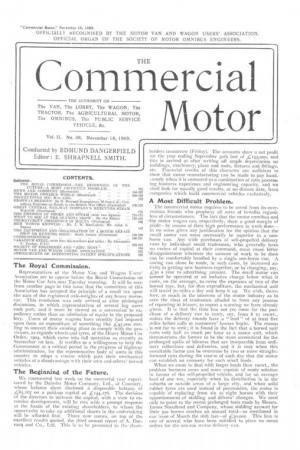The Royal Commission.
Page 1

If you've noticed an error in this article please click here to report it so we can fix it.
Representatives of the Motor Van and Wagon Users' Association are to appear before the Royal Commission on the Motor Car Acts next Tuesday morning. It will be seen from another page in this issue that the committee of this Association has accepted the principle of a small tax upon the sum of the registered axle-weights of any heavy motorcar. This resolution was only arrived at after prolonged discussion, in which representatives of several big users took part, and it must be viewed as a concession • to expediency rather than an admission of equity in the proposed levy. Users of motor wagons have recently had imposed upon them an expenditure of something like ,'45,000 sterling to convert their existing plant to comply with the provisions, as regards wheels and tyres, of the Heavy Motor Car Order, 1904, which came into full operation so recently as September 1st last. It testifies to a willingness to help the Government at a critical period in the progress of highway administration, for the representative body of users in this country to adopt a course which puts their mechanical vehicles at a disadvantage with their own and others' horsed vehicles.
The Beginning of the Future.
We commented last week on the successful year experienced by the Daimler Motor Company, I.td., of Coventry, whose alance sheet disclosed a disposable balance Of £83,x67 on a paid-up capital of .144,176. The decision -of the directors to increase the capital, with a view to extensive developments, will be met with a prompt response at the hands of the existing shareholders, to whom the opportunity to take up additional shares in the undertaking will be afforded first. There now comes, on top of the -excellent results quoted, the third annual report of A. Darracq and Co., Ltd. This is to be presented to the share
holders to-morrow (Friday). The accounts show a net profit for the year ending September 30th last of £153,000, and this is arrived at after writing off ample depreciation on buildings, machinery, plant and tools, fixtures and fittings, etc. Financial results of this character are sufficient to show that motor manufacturing can be made to pay handeinely when it is entrusted to a combination of men possessing business experience and engineering capacity, and we shall look for equally good results, at no distant date, from companies which build commercial vehicles exclusively.
A Most Difficult Problem.
The commercial motor requires to be saved from its overzealous friends who prophesy all sorts of benefits regardless of circumstances. The fact that the motor omnibus and the motor wagon can, respectively, show a good margin of profit—by reason of their high performance in work done— in no sense gives any justification for the opinion that the small motor van must necessarily be superior to a onehorse van. Any wide purchases of self-propelled delivery vans by individual small tradesmen, who generally have no excess of capital at their command, must cause bitter 'disappointment wherever the amount of work to be done can be comfortably handled by a single one-horse van. A saving can alonebe made, in such cases, by increased activity in getting new business together, or by charging, say, ;4,30 a year to advertising account. The small motor van cannot be operated at an inclusive charge below what it costs, on the average, to cover the expenses of two of the horsed type, but, for that expenditure, the mechanical unit will travel 70 miles a day and keep it up. We wish, therefore, as much in the interests of the motor industry as to save the class of tradesmen alluded to from any process of repenting at leisure, to repeat a warning we have already given. It is that the time has not yet come for the purchase of a delivery van to carry, say, from 8 to tocwt., linless the delivery rounds have a "lead " of at least five miles before calls at customers' houses begin. The reason 6 not far to seek; it is found in the fact that a horsed unit costs only half as much per hour as a motor unit, which demonstrates the former to be the more economical for the prolonged spells of idleness that are inseparable from ordinary collections and deliveries, and it is only when this unsuitable factor can be overcome by two or more straightforward runs during the courte of each day that the motor can establish an economy for such small loads.
When we come to deal with larger loads than tocwt., the problem becomes more and more capable of ready solution in favour of the self-propelled vehicle, and for an average load of one ton, especially when its distribution is in the suburbs or outside areas of a large city, and when solid rubber tyres are used instead of pneumatics, the motor is capable of replacing from six to eight horses with their apportionment of stabling and drivers' charges. We need only to point to the recent prolonged tests made by Messrs. James Shoolbred and Company, whose stabling account for their loo horses reaches an annual total—as mentioned in our issue of March the t6th last—of ,4;30,000. This firm is one of several who have been satisfied to place no mean orders for the one-ton motor delivery van.
































